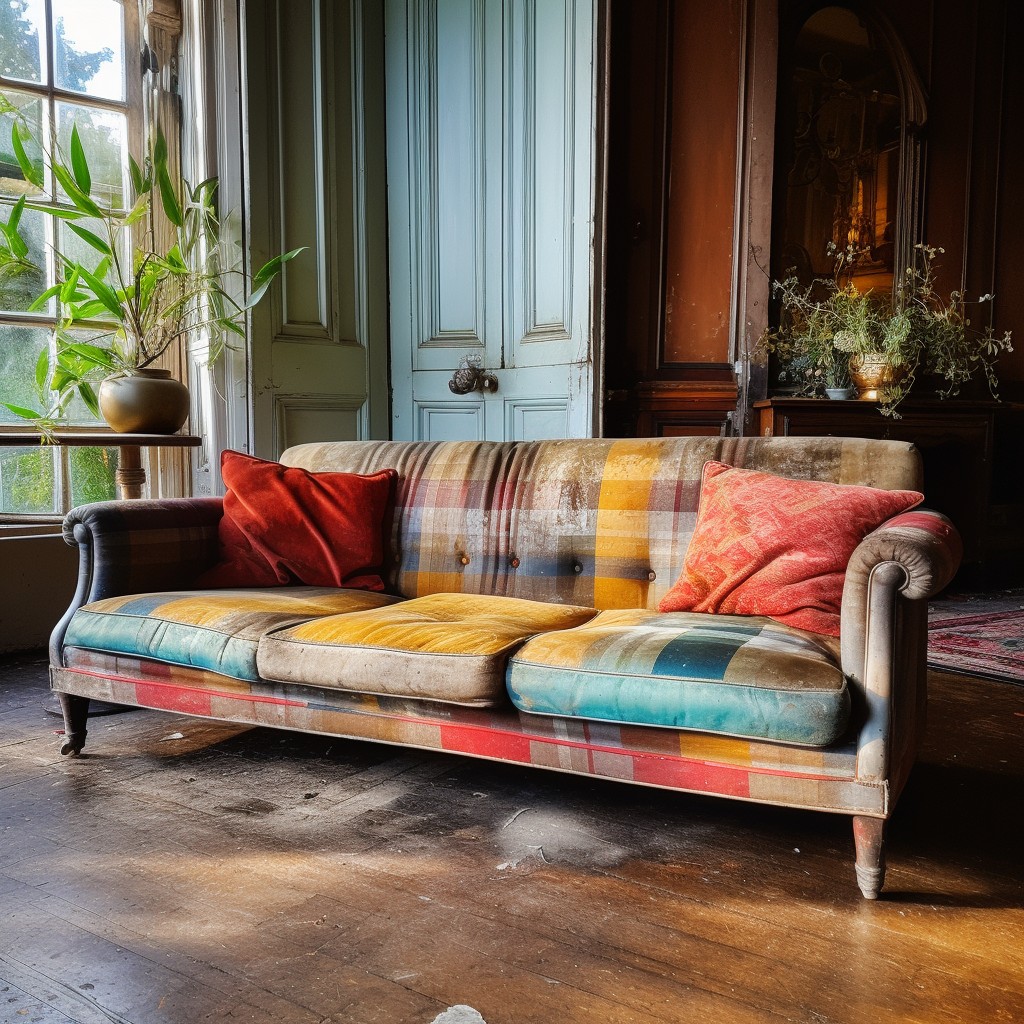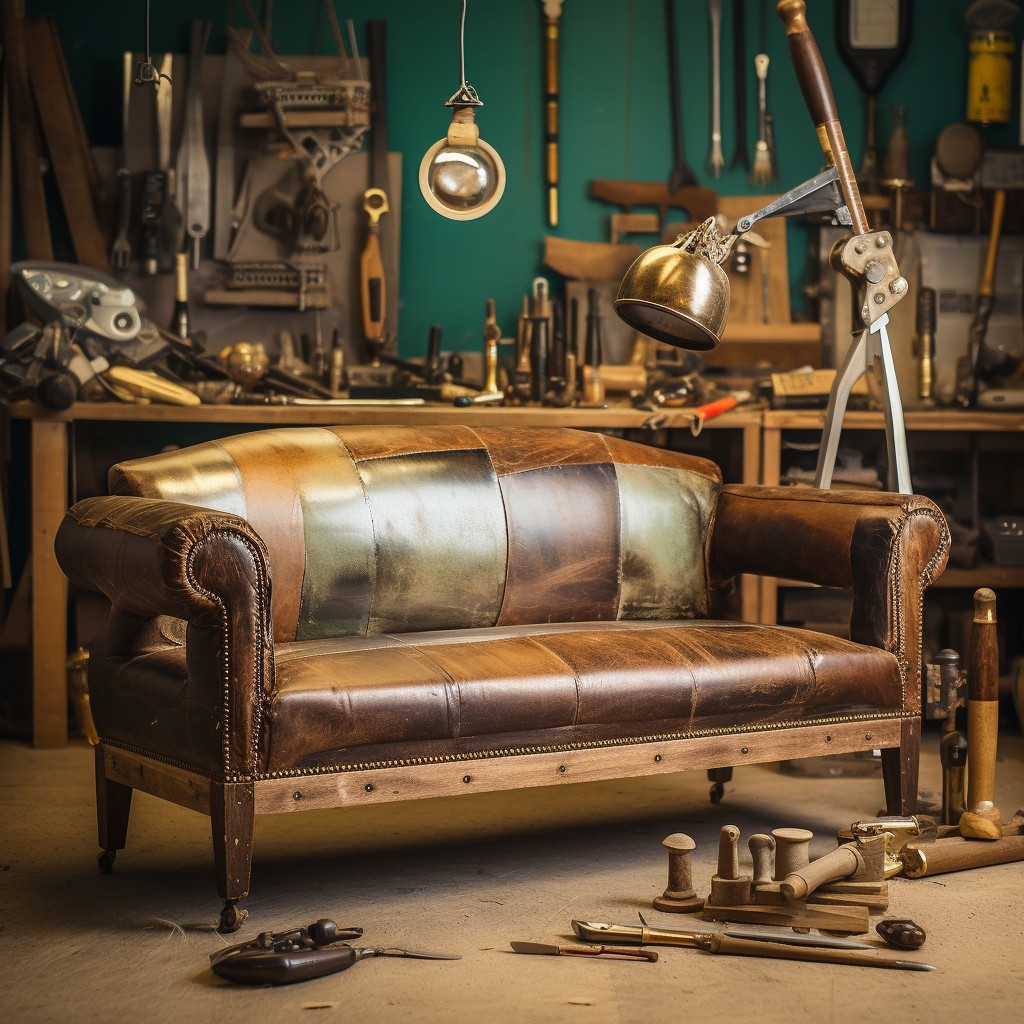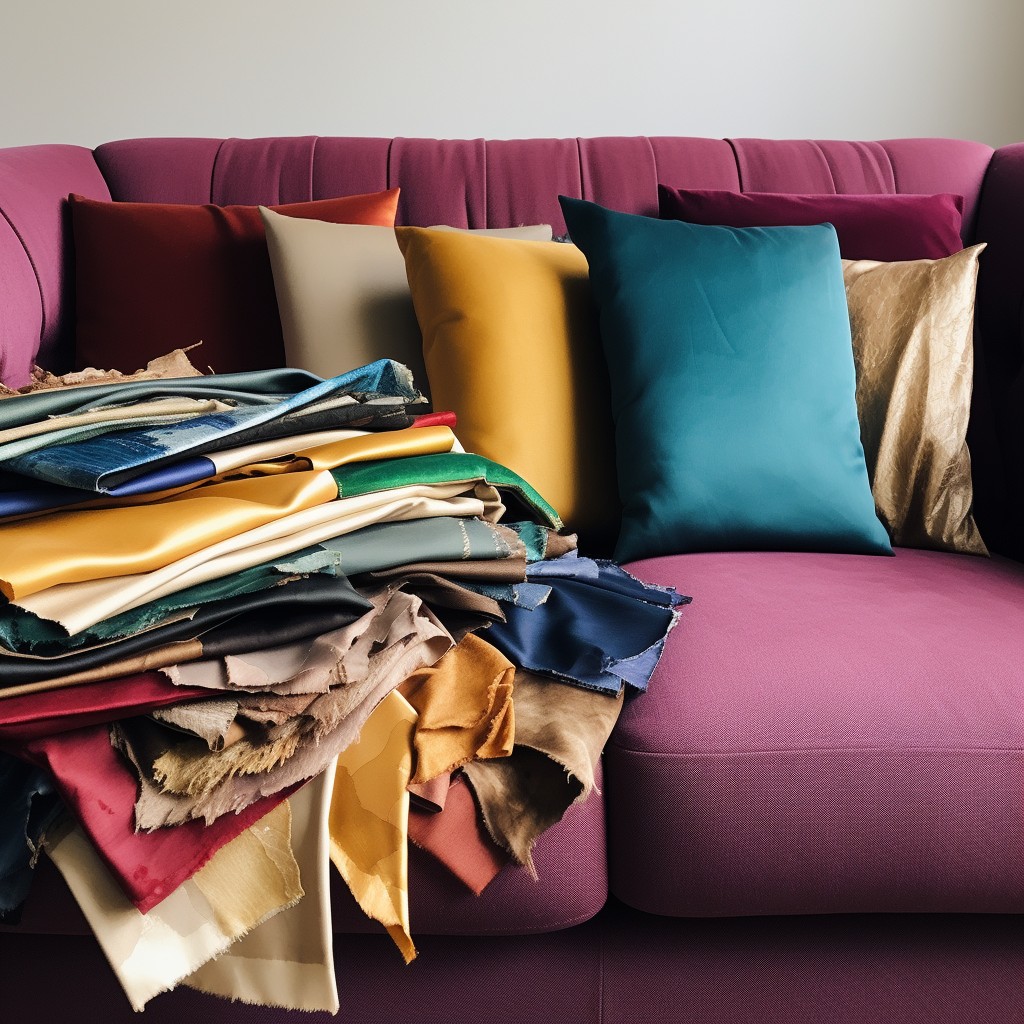Last updated on
Discover the transformative power of refurbishing a couch as we guide you through simple yet effective techniques to revitalize your old furniture and give it a fresh, new look.
After years of use, your once-beloved couch may start to show signs of wear and tear. The cushions may be sagging, the upholstery may be stained or faded, and the overall look of your living room centerpiece might not be as inviting as it once was.
But before you consider throwing it out and buying a new one, have you ever considered refurbishing your couch? In this article, we’ll show you how to give your old couch a new lease on life with some easy-to-follow tips and tricks. From reupholstering to replacing cushions, we’ve got you covered on all things couch refurbishment.
So grab some tools and let’s get started!
Table of Contents
Project Overview

Before diving into the nitty-gritty of refurbishing your couch, it’s important to have a clear understanding of what this project entails. Refurbishing a couch involves giving new life to an old piece of furniture by replacing or repairing its upholstery, cushions, and frame.
This process can be time-consuming and requires some basic DIY skills such as sewing and using power tools. However, with patience and attention to detail, you can transform your worn-out sofa into a beautiful centerpiece that will last for years to come.
In the following sections of this article we’ll guide you through each step in detail so that you feel confident taking on this exciting project!
Assessing the Couch Condition

Before you start any work, take a close look at your sofa and determine what needs to be fixed or replaced. Check for sagging cushions, broken springs, and damaged frames.
If the upholstery is stained or faded but the rest of the couch is in good shape, then reupholstering might be all that’s needed to give it new life.
However, if there are structural issues with your couch such as broken frames or worn-out springs that cannot support weight anymore; it may not be worth investing time and money into refurbishing it yourself. In this case, consider hiring a professional upholsterer who can provide an expert opinion on whether repairing your old furniture piece makes sense financially.
Assessing the condition of your sofa will help you decide which steps need to be taken next in order for you to achieve optimal results from this project while staying within budget constraints.
Time and Tools Required

Depending on the extent of damage or wear, this could be a weekend DIY job or a more extensive process that requires professional help. You’ll need basic tools such as pliers, screwdrivers, staple guns and sewing machines if you plan to reupholster your couch yourself.
Consider investing in specialized upholstery tools like webbing stretchers and tack hammers for better results. The amount of time needed will depend on factors such as how much work needs to be done on repairing the frame or springs before reupholstering can begin.
It’s also worth noting that some steps may require drying times between coats of paint or glue application which can add extra days onto your timeline. Overall though with patience and persistence anyone can refurbish their own sofa with great results!
Choosing a Fabric Material

Not only does it affect the overall look and feel of your furniture, but it can also impact its durability and longevity. Before you start shopping for fabrics, consider factors such as color scheme, texture preference, and practicality.
If you have kids or pets in your home or if your couch gets a lot of use on a daily basis, opt for durable materials like leather or microfiber that are easy to clean and maintain. On the other hand, if you’re looking for something more luxurious or decorative that won’t be used as frequently then velvet might be an excellent choice.
Additionally keep in mind that some fabrics may require special care instructions when cleaning them so make sure to read up on those before making any final decisions. Ultimately though there’s no one-size-fits-all solution when selecting upholstery fabric – choose what works best with both your personal style preferences as well as practical needs!
Budget Considerations
While reupholstering your old sofa can be more cost-effective than buying a new one, the costs can still add up quickly. Before you start your project, take some time to assess how much you’re willing and able to spend on materials and labor.
One way to save money is by choosing a less expensive fabric material or opting for pre-owned fabrics that are still in good condition. You may also consider doing some of the work yourself instead of hiring professionals for every step of the process.
However, keep in mind that cutting corners on quality materials or rushing through steps could result in subpar results that won’t last as long as they should. So while budget considerations are important when refurbishing your couch, don’t sacrifice quality over cost savings if possible.
Removing Old Upholstery
This step is crucial in ensuring that your refurbished couch looks its best and feels comfortable to sit on.
To begin, carefully remove any decorative elements such as buttons or trim from the old upholstery. Then use a pair of pliers to pull out any staples or tacks holding the fabric in place.
Be sure not to damage any underlying foam padding or cushioning during this process.
Next, gently peel back each section of fabric until all pieces have been removed from the frame. Take note of how each piece was attached so that you can replicate this when attaching new upholstery later on.
If there are areas where foam padding has deteriorated over time, now is also an excellent opportunity to replace it with fresh stuffing for added comfort and support.
Repairing the Couch Frame
This is a crucial step in refurbishing your couch as it ensures that it will be sturdy and durable for years to come. The first thing you need to do is remove any old staples or nails from the frame using pliers or a staple remover tool.
Next, inspect all joints and connections for damage or looseness. If there are any cracks in the wood, use wood glue to fill them in before clamping them together until they dry completely.
If there are broken pieces of wood on your couch’s frame, replace them with new ones by cutting out matching pieces from plywood and attaching them with screws.
Reinforce weak spots by adding metal brackets at key points along the frame’s structure. These brackets can be found at most hardware stores and should be screwed into place securely.
Reinforcing the Springs
Over time, springs can become worn out or break entirely, causing your couch to sag and lose its shape. To fix this issue, you’ll need some basic tools like pliers and wire cutters.
Firstly, remove any broken or damaged springs from their clips using pliers. Then measure new spring lengths by stretching them across a flat surface with a tape measure.
Next up is attaching new S-shaped sinuous (zigzag) springs in place of old ones using metal clips that come with them. Make sure they are evenly spaced apart for optimal support before securing each end of every spring into place on both sides of your sofa frame.
Use wire cutters to trim excess length off any protruding ends so they don’t poke through fabric later on when reupholstering your sofa.
Restuffing the Cushions
If they’re sagging or lumpy, restuffing them is a must for achieving that brand-new look and feel. Start by removing all of the stuffing material from inside each cushion cover.
You can use foam rubber or polyester batting as filling materials for your cushions.
If you choose foam rubber, measure and cut it to fit snugly into each cushion cover before inserting it in place. For polyester batting, fluff up small amounts at a time with your hands and stuff them evenly into each cushion until they reach their desired fullness level.
It’s important not to overstuff or under-stuff the cushions; otherwise, they’ll be uncomfortable to sit on and won’t hold their shape properly over time.
Cutting and Attaching New Upholstery Fabric
This step requires precision cutting skills to ensure that your new upholstery fits perfectly on your couch. Start by measuring each section of the couch where you will be attaching new fabric.
Use a sharp pair of scissors or a rotary cutter to cut out pieces of fabric according to these measurements.
Next, lay out each piece of cut-out fabric onto its corresponding section on the couch before attaching it with staples or tacks. Make sure that there are no wrinkles or creases in the material as this can affect how well it adheres over time.
When stapling or tacking down your newly-cut pieces of upholstery material onto their respective sections on the sofa frame, make sure they are pulled tight enough so that there is no sagging but not too tight as this could cause puckering in some areas.
Sewing Techniques
Sewing techniques are crucial in ensuring that your couch looks neat and professional. You will need a heavy-duty sewing machine with a strong needle capable of handling thick fabrics like denim or canvas.
Start by pinning the fabric pieces together along the seams, making sure they align perfectly. Then sew them together using a straight stitch or zigzag stitch for added strength.
For corners and curves, use small stitches to prevent puckering or bunching up of fabric. If you’re adding piping trim around cushions or edges, attach it before sewing all pieces together for an even finish.
Remember to backstitch at both ends of each seam to secure the thread in place and prevent unraveling over time.
Attaching New Cushion Covers
This is where choosing the right fabric comes into play. You’ll want a durable material that can withstand daily wear and tear while also complementing your overall decor style.
To start, measure the dimensions of each cushion and add an extra inch on all sides for seam allowance. Cut out pieces of fabric accordingly, making sure to match any patterns or designs if necessary.
Next, sew together the sides of each cover piece with a sewing machine or by hand using a needle and thread. Leave one side open so you can insert the cushion inside.
Once inserted, fold in the edges of the open side and sew it closed using either a hidden stitch or visible topstitch depending on your preference.
Add any finishing touches such as corded trim around the edges for added durability and aesthetic appeal.
Adding Corded Trim and Finishing Touches
One way to achieve this is by adding corded trim. Corded trim is a decorative rope-like material that can be sewn onto the edges of cushions or along the seams of upholstery fabric for added texture and detail.
To add corded trim, start by measuring the length of each section where you want to apply it. Cut your cord slightly longer than needed so that you have enough slack for sewing around corners or curves.
Next, fold over one end of your cording and pin in place at one corner or seam edge on top side facing up (right side). Sew down close to folded edge using a zipper foot attachment if available; continue sewing all around until reaching starting point again – leave excess hanging off at both ends.
Fold under raw end about 1/2 inch from last stitch line before tucking inside folded-over beginning piece; sew across entire length with regular presser foot attachment making sure not catch any other layers underneath as they may cause puckering when pulled tight during use over time.
Reapplying the Dust Cover
The dust cover is a thin layer of fabric that covers the underside of your couch and prevents dust from accumulating inside. To begin, measure and cut a piece of fabric that will fit over the bottom frame of your couch.
Make sure to leave enough excess material on all sides so you can staple it securely in place.
Next, position the fabric over your couch frame and use a staple gun to attach it along one edge. Pull tautly as you go along each side until all edges are stapled down securely.
Once complete, trim any excess material with scissors or shears for a neat finish. Reapplying this final touch ensures not only an aesthetically pleasing look but also helps protect against future wear-and-tear by keeping dirt out from under your newly refurbished sofa.
Couch Care Tips
Here are some tips on how to maintain your newly revamped furniture:
1. Vacuum regularly: Dust and dirt can accumulate quickly on upholstery, so make sure you vacuum your couch at least once a week.
2. Rotate cushions: To prevent uneven wear and tear, rotate the cushions every few months.
3. Avoid direct sunlight: Sunlight can cause fading and damage the fabric over time, so try not to place your couch in direct sunlight or use window treatments if necessary.
4. Clean up spills immediately: Accidents happen! If something spills on the sofa, clean it up as soon as possible with a damp cloth or sponge before any stains set in.
5. Use appropriate cleaning products: Always check manufacturer instructions before using any cleaning products on your sofa; some fabrics may require special care or specific cleaners.
DIY Vs. Hiring a Pro
While the former may seem like an attractive option for those on a budget, it’s important to consider your skill level and the complexity of the project before diving in. Refurbishing furniture requires patience, attention to detail, and some basic knowledge of upholstery techniques.
If you’re confident in your abilities and have experience with similar projects, then DIY might be right up your alley. However, if you’re unsure about any aspect of refurbishing or lack confidence in your skills – especially when dealing with structural repairs – then hiring a pro is probably best.
Professional upholsterers can offer expert advice on fabric selection as well as provide quality workmanship that will ensure longevity for years to come. They also have access to specialized tools that are necessary for certain aspects of reupholstering such as sewing machines designed specifically for heavy-duty fabrics.
Professional Help Options
Upholsterers specialize in furniture restoration and can provide expert advice on fabric choices, cushion filling materials, and repair techniques. They also have access to a wider range of fabrics than what’s typically available at retail stores.
Before hiring an upholsterer, do some research online or ask for recommendations from friends and family members who’ve had similar work done. Check their portfolio of previous projects to ensure they have experience working with sofas similar to yours.
Keep in mind that professional reupholstery services can be costly depending on the extent of the work required and choice of fabric material. However, if you want a high-quality finish without any hassle or stress involved then it may be worth considering this option.
Ultimately whether you choose DIY refurbishment or hire a pro will depend on your budget constraints as well as personal preferences regarding time investment versus cost savings.
Time and Cost of Reupholstering a Sofa
The amount of time required to complete the refurbishment process will depend on several factors, including the size of your couch, its condition, and your level of experience with DIY projects. On average, reupholstering a sofa can take anywhere from 20-40 hours or more.
As for cost considerations when refurbishing your couch – this will also vary depending on several factors such as fabric choice (leather is usually more expensive than other materials), cushion filling type (down feathers are pricier than foam), labor costs if you hire professionals to do it for you versus doing it yourself.
However daunting these figures may seem at first glance; remember that investing in quality upholstery work means extending the life span of an otherwise worn-out piece while giving new life to something old.
Recommended Tools and Supplies
Here are the recommended ones:
1. Upholstery fabric: Choose a durable and easy-to-clean material that matches your decor.
2. Sewing machine: A heavy-duty sewing machine is ideal for working with thick fabrics.
3. Scissors: Invest in high-quality scissors to cut through upholstery fabric easily.
4. Staple gun and staples: Use these to attach new upholstery fabric securely to the couch frame.
5. Webbing stretcher or pliers: These tools help stretch webbing tightly across the couch frame for added support.
6. Foam cutter or electric knife: Cut foam cushions precisely without tearing them apart using these specialized cutting tools.
7. Tack hammer and nails/tacks/staples remover tool: Remove old tacks, nails, or staples from your furniture with ease using this tool.
8. Spray adhesive/glue gun: Use spray adhesive on foam cushioning before covering it up with batting; glue guns can be used when attaching trimmings like corded edges.
Final Thoughts
Refurbishing your old furniture not only saves you money but also helps reduce waste by keeping perfectly good pieces out of landfills. Remember to take care of your newly refurbished couch by regularly cleaning it and avoiding spills or stains as much as possible.
If you’re feeling inspired to tackle more DIY projects around the house, don’t hesitate to try other refurbishment techniques on different pieces of furniture. With some creativity and patience, anything is possible!
FAQ
Is it hard to refurbish a couch?
Refurbishing a couch can be challenging, as it is a time-consuming process that requires research, note-taking, and studying the couch before starting the project.
Is it a good idea to reupholster a couch?
Reupholstering a couch is a good idea, as it promotes sustainability, supports local workroom professionals, and saves functional furniture from landfills.
How do you reupholster a couch without removing old fabric?
To reupholster a couch without removing old fabric, simply lay the new fabric over the couch, tuck 6"-12" of it into each fold for a tight fit, and ensure it remains taut to reduce the chances of it coming loose.
What are the essential tools and materials needed for a couch refurbishment project?
Essential tools and materials for a couch refurbishment project include fabric, foam, batting, a sewing machine, scissors, a staple gun, needles, thread, and upholstery tools.
How can one assess whether a couch is worth refurbishing or better to replace?
To determine if a couch is worth refurbishing or better to replace, consider factors such as structural condition, comfort, fabric quality, and overall cost-effectiveness.
What are some techniques to keep the project budget-friendly while refurbishing a couch?
Some techniques to keep the project budget-friendly while refurbishing a couch include using affordable materials, doing the work yourself, and repurposing existing materials.




